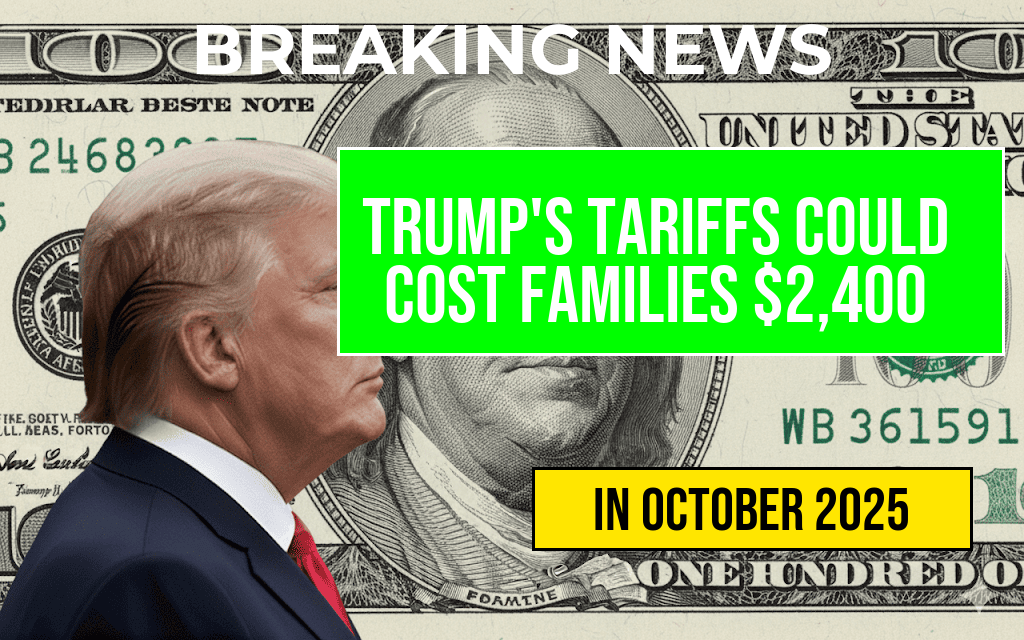Recent analyses suggest that former President Donald Trump’s tariffs could impose a significant financial burden on American families, with estimates indicating an annual cost of approximately $2,400 per household. This phenomenon, often referred to as the “Turbulence Tax,” has raised concerns among economists and consumers alike, as it affects the prices of everyday goods ranging from clothing to electronics. As the nation grapples with inflation and rising costs, understanding the implications of these tariffs is crucial for families navigating their financial landscapes.
What Are Trump’s Tariffs?
Trump’s tariffs were implemented during his administration as part of a broader strategy to protect American industries and reduce trade deficits, particularly with China. These tariffs primarily targeted imported goods, imposing additional costs on products that American consumers rely on daily. While the intention was to incentivize domestic production, the unintended consequences have led to increased prices for consumers.
The Impact on Household Budgets
According to a report by the American Economic Association, the average American household is facing an additional $2,400 in annual expenses due to these tariffs. This figure is derived from increased prices on a variety of goods, which are directly linked to the tariffs imposed on imports. The burden is particularly heavy for lower and middle-income families, who typically allocate a larger portion of their budgets to essentials.
Key Goods Affected by Tariffs
- Electronics: Smartphones and laptops have seen price hikes due to tariffs on components.
- Clothing: Apparel prices have increased, affecting family budgets significantly.
- Household Items: Everyday goods, from kitchenware to furniture, have also been impacted.
Economic Consequences of Tariffs
The economic repercussions of Trump’s tariffs extend beyond immediate consumer costs. Experts warn that prolonged tariff policies can lead to trade wars, disrupting supply chains and negatively impacting American exports. A World Trade Organization report indicates that such disruptions can have long-lasting effects on global trade dynamics, ultimately hurting the U.S. economy.
Consumer Sentiment and Behavior
As families confront rising prices, consumer sentiment has shifted. Many households are adjusting their spending habits to accommodate the added costs, leading to changes in purchasing decisions. A survey conducted by the Pew Research Center indicated that over 60% of respondents are now more cautious about their spending, with many opting for lower-cost alternatives or delaying purchases altogether.
Political Reactions and Future Implications
The political landscape surrounding tariffs remains contentious. While some lawmakers argue that tariffs are necessary for protecting American jobs, others contend that they disproportionately harm consumers. As the 2024 presidential election approaches, candidates are likely to address these economic issues, with tariffs becoming a focal point in debates about trade policies and their impact on American families.
The Path Forward
The future of tariffs and their implications for American households remains uncertain. Continued advocacy for fair trade practices may lead to shifts in policy, potentially alleviating some of the financial burdens currently faced by families. Policymakers are urged to consider the long-term effects of tariffs and explore alternative strategies that promote economic growth while minimizing consumer costs.
| Category | Annual Cost ($) |
|---|---|
| Electronics | 800 |
| Clothing | 600 |
| Household Items | 400 |
| Other Goods | 600 |
As families continue to adapt to the financial strains imposed by tariffs, the discourse surrounding trade policies will undoubtedly evolve. Addressing these issues is vital for ensuring that American households can thrive in a challenging economic landscape.
Frequently Asked Questions
What are Trump’s tariffs and how do they affect families?
Trump’s tariffs are taxes imposed on imported goods, which can lead to increased prices for consumers. Families may face higher costs on everyday products, contributing to what is termed the ‘Turbulence Tax’.
How much can families expect to pay due to these tariffs?
According to estimates, families could face an annual cost increase of approximately $2,400 as a result of the tariffs, affecting their overall household budget.
What is the ‘Turbulence Tax’?
The ‘Turbulence Tax’ refers to the economic strain and additional costs that families incur due to the implementation of tariffs, leading to heightened prices on imported goods.
Which products are most affected by the tariffs?
The tariffs primarily affect a wide range of imported goods, including consumer electronics, clothing, and household items, making these products more expensive for families.
Are there any potential benefits to the tariffs for American businesses?
While the tariffs aim to protect American manufacturers by encouraging consumers to buy domestic products, they can also lead to higher prices for families, creating a complex economic situation.

Leave a Reply